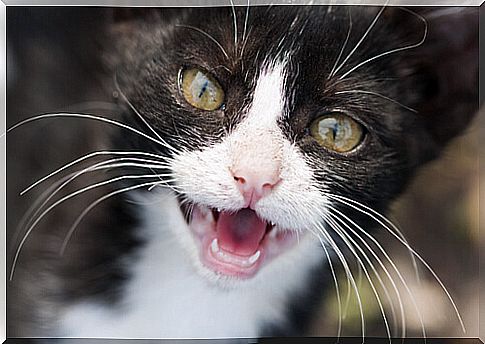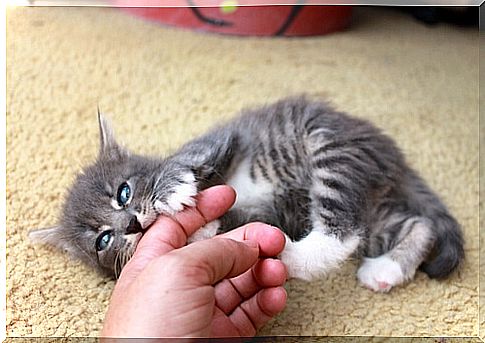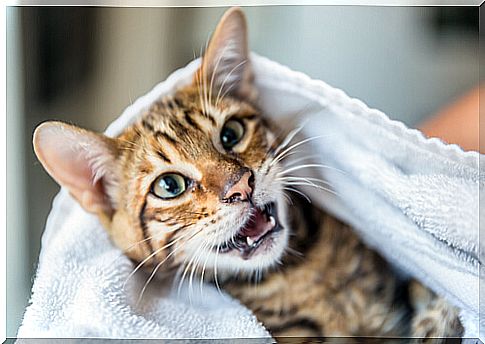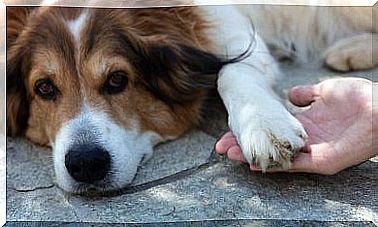How To Treat An Aggressive Cat?

Aggression is one of the most common behavior problems in felines ; and it tends to more commonly affect indoor cats that are not properly stimulated. Here are some practical tips to prevent and treat an aggressive cat.
How to recognize an aggressive cat?
Feline aggression has its symptoms and can be easily diagnosed. It is a behavioral disorder and must be manifested with a certain frequency, under different circumstances.
To begin with, an aggressive cat cannot be considered for isolated episodes of tension or stress. Here are five signs that your cat is turning violent:
- Demonstrate fearful attitudes and / or behaviors.
- Demonstrate repetitive defensive behaviors in relation to their master.
- Rubbing the head excessively.
- Whip its tail frequently.
- Urinate and defecate out of the litter box.
- Hide and avoid coexistence with third parties.

Treating an aggressive cat: rule out pathological causes
If your cat begins to present these behaviors repeatedly, the ideal is to consult a veterinarian as quickly as possible. Behavioral changes are often the only visible symptom of many diseases.
Aggression can develop as a consequence of some pathology that makes it vulnerable or hypersensitive. Often times, aggressive behaviors appear as a way of expressing pain and fear.
The conditions most commonly associated with behavioral changes and irritability in felines are:
- Bacterial and viral infections.
- Hyperthyroidism
- Hypertension.
- Osteoarthritis.
- Tumors and some types of cancer.
Five tips to treat and prevent an aggressive cat
Having ruled out any disease, we must pay close attention to the environment and routine of domestic felines. Typically, an aggressive cat is bored, nervous, sedentary, and physically and mentally unstimulated.
To improve this panorama, it is essential to provide a more active and stimulating life for your cat. These are five simple tips to reduce your pet’s irritability and treat his aggressiveness:
1- Never use violence or force
Violence is harmful and blocks the ability to learn in all species. Positive reinforcement for good behaviors is essential and more efficient to educate your pet.
In addition, a feline should not be forced to adopt certain behaviors or practice certain activities. And this can increase aggressiveness and cause more serious behavior disorders. That is why it is best to positively encourage the will of the animal.
2- Strategic location of your objects
Felines feel more vulnerable when it comes to eating, drinking water and fulfilling their physiological needs. This is part of your instinct for self-preservation.
Thus, it is recommended to locate your drinker, feeder and sandbox in a quiet and safe place. It is important to avoid placing them in very noisy and high traffic areas.
3- Places to climb and scratch
Cats that are in the wild tend to climb and scratch very frequently during the days. This is how they have fun, waste energy and exercise; It is important to offer them places in your home where they can climb, scratch, hide and rest.
4- Moments of interaction
For those who have time and space availability, it is interesting to prefer to have two or more cats. Co-parenting and daily living can help socialize your pet, in addition to fighting sedentary lifestyle and boredom.
It is also essential to dedicate moments of your day to play and interact with your cat. Despite their independence, they too enjoy our company and purr as a sign of well-being.
5- Provide stimulating toys and games
This is another tip to avoid boredom and increase positive energy expenditure, so it is essential to offer games to develop physically and mentally your cat.
To begin with, toys with little physical contact are preferred so as not to scare him: wands, feathers, balls, etc. The feline can also be sensually stimulated with videos, music, sounds and herbs.

Socialize to prevent territorial aggressiveness
Felines are extremely territorial : it is their way of surviving and imposing themselves against their predators. This is why a little aggressiveness is essential for your cat, since it is part of its character and nature.
The objective of socialization is to prevent the appearance of aggressive behaviors, mainly due to dominance of territory. Games and socializing practices teach the animal to interact in a more pleasant way with humans and other animals.
Socializing a feline is a process that requires a lot of patience. Ideally, start it during the first weeks of the cat’s life, preferably between the fourth and twentieth; in this period he assimilates his notions of coexistence and sociability.
The feline socialization process must be accompanied by a controlled desensitization therapy. This makes it possible to reduce the intensity of the responses to various stimuli and calm the character of an aggressive cat.









